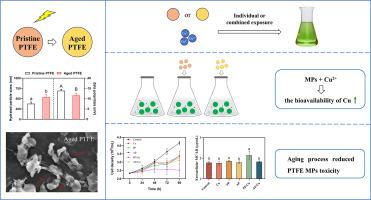当前位置:
X-MOL 学术
›
Aquat. Toxicol.
›
论文详情
Our official English website, www.x-mol.net, welcomes your
feedback! (Note: you will need to create a separate account there.)
Effect of ultraviolet aged polytetrafluoroethylene microplastics on copper bioavailability and Microcystis aeruginosa growth
Aquatic Toxicology ( IF 4.1 ) Pub Date : 2024-05-21 , DOI: 10.1016/j.aquatox.2024.106967 Juanjuan Zhang 1 , Zihan Lin 1 , Fuxun Ai 1 , Wenchao Du 2 , Ying Yin 3 , Hongyan Guo 3
Aquatic Toxicology ( IF 4.1 ) Pub Date : 2024-05-21 , DOI: 10.1016/j.aquatox.2024.106967 Juanjuan Zhang 1 , Zihan Lin 1 , Fuxun Ai 1 , Wenchao Du 2 , Ying Yin 3 , Hongyan Guo 3
Affiliation

|
Microplastics (MPs) are ubiquitous in aquatic environments, which can act as carriers to affect the bioavailability of heavy metals. The aging process in the environment changes the physicochemical properties of MPs, thereby affecting their environmental behavior and co-toxicity with other pollutants. However, relevant research is limited. In this study, we compared the properties and Cu adsorption capacity of pristine and aged polytetrafluoroethylene (PTFE) MPs and further explored the influence on copper bioavailability and bio-effects on . Aging process induced surface oxidation and cracks of PTFE MPs, and decreased the stability of MPs in water by increasing zeta potential. PTFE MPs had a strong adsorption capacity for Cu and increased the bioavailability of copper to microalgae, which was not affected by the aging process. Pristine and aged PTFE MPs adhered to cyanobacterium surfaces and caused shrinkage and deformation of cells. Inhibition of cyanobacterium growth, photosynthesis and reduction of total antioxidant capacity were observed in the treatment of PTFE MPs. Combined exposure of pristine MPs and Cu had stronger toxic effects to cyanobacterium, and increased Microcystin-LR release, which could cause harm to aquatic environment. Aging reduced the toxic effects of PTFE MPs on microalgae. Furthermore, soluble exopolysaccharide (EPS) content was significantly higher in co-exposure of aged MPs and Cu, which could reduce the toxicity to cyanobacterium cells. These results indicate that aging process alleviates the toxicity to microalgae and environmental risks caused by PTFE MPs. This study improves understanding of the combined toxicity of aged MPs and metals in freshwater ecosystems.
中文翻译:

紫外线老化聚四氟乙烯微塑料对铜生物利用度和铜绿微囊藻生长的影响
微塑料(MP)在水生环境中无处不在,它可以作为载体影响重金属的生物利用度。环境中的老化过程改变了MP的理化性质,从而影响其环境行为以及与其他污染物的共毒性。然而,相关研究有限。在本研究中,我们比较了原始和老化的聚四氟乙烯(PTFE)MP的性能和铜吸附能力,并进一步探讨了其对铜生物利用度和生物效应的影响。老化过程引起PTFE MPs的表面氧化和裂纹,并通过增加zeta电位来降低MPs在水中的稳定性。 PTFE MPs对铜有很强的吸附能力,提高了微藻对铜的生物利用度,且不受老化过程的影响。原始和老化的 PTFE MP 粘附在蓝藻表面,导致细胞收缩和变形。在 PTFE MP 处理中观察到蓝藻生长、光合作用受到抑制,总抗氧化能力降低。原始MPs和Cu的联合暴露对蓝藻具有更强的毒性作用,并且增加了微囊藻毒素-LR的释放,可能对水生环境造成危害。老化降低了 PTFE MP 对微藻的毒性作用。此外,老化MPs和Cu共同暴露时,可溶性胞外多糖(EPS)含量显着升高,这可以降低对蓝藻细胞的毒性。这些结果表明,老化过程减轻了 PTFE MP 对微藻的毒性和环境风险。这项研究增进了对淡水生态系统中老化 MP 和金属的综合毒性的了解。
更新日期:2024-05-21
中文翻译:

紫外线老化聚四氟乙烯微塑料对铜生物利用度和铜绿微囊藻生长的影响
微塑料(MP)在水生环境中无处不在,它可以作为载体影响重金属的生物利用度。环境中的老化过程改变了MP的理化性质,从而影响其环境行为以及与其他污染物的共毒性。然而,相关研究有限。在本研究中,我们比较了原始和老化的聚四氟乙烯(PTFE)MP的性能和铜吸附能力,并进一步探讨了其对铜生物利用度和生物效应的影响。老化过程引起PTFE MPs的表面氧化和裂纹,并通过增加zeta电位来降低MPs在水中的稳定性。 PTFE MPs对铜有很强的吸附能力,提高了微藻对铜的生物利用度,且不受老化过程的影响。原始和老化的 PTFE MP 粘附在蓝藻表面,导致细胞收缩和变形。在 PTFE MP 处理中观察到蓝藻生长、光合作用受到抑制,总抗氧化能力降低。原始MPs和Cu的联合暴露对蓝藻具有更强的毒性作用,并且增加了微囊藻毒素-LR的释放,可能对水生环境造成危害。老化降低了 PTFE MP 对微藻的毒性作用。此外,老化MPs和Cu共同暴露时,可溶性胞外多糖(EPS)含量显着升高,这可以降低对蓝藻细胞的毒性。这些结果表明,老化过程减轻了 PTFE MP 对微藻的毒性和环境风险。这项研究增进了对淡水生态系统中老化 MP 和金属的综合毒性的了解。











































 京公网安备 11010802027423号
京公网安备 11010802027423号